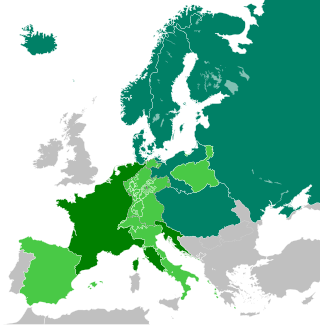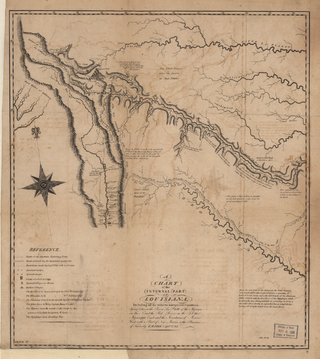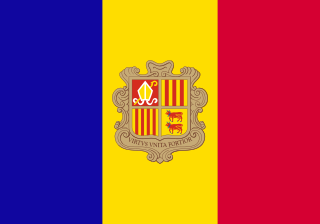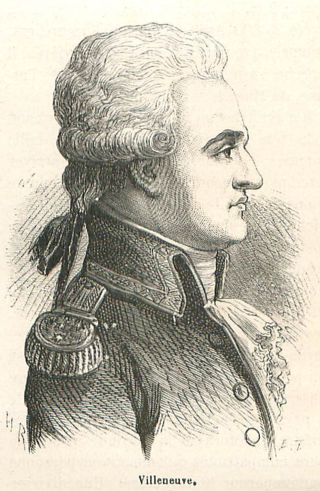Events
| | This section needs expansion. You can help by adding to it. (October 2015) |
| Years in Spain: | 1803 1804 1805 1806 1807 1808 1809 |
| Centuries: | 18th century · 19th century · 20th century |
| Decades: | 1770s 1780s 1790s 1800s 1810s 1820s 1830s |
| Years: | 1803 1804 1805 1806 1807 1808 1809 |
Events from the year 1806 in Spain
| | This section needs expansion. You can help by adding to it. (October 2015) |
| | This section needs expansion. You can help by adding to it. (October 2015) |
| | This section needs expansion. You can help by adding to it. (October 2015) |

Francis II and I was the last Holy Roman Emperor as Francis II from 1792 to 1806, and the first Emperor of Austria as Francis I from 1804 to 1835. He was also King of Hungary, Croatia and Bohemia, and served as the first president of the German Confederation following its establishment in 1815.

The Napoleonic Wars (1803–1815) were a series of conflicts fought between the French First Republic (1803–1804) and First French Empire (1804–1815) under the First Consul and Emperor of the French Napoleon Bonaparte and a fluctuating array of European coalitions. The wars originated in political forces arising from the French Revolution (1789–1799) and from the French Revolutionary Wars (1792–1802) and produced a period of French domination over Continental Europe. The wars are categorised as seven conflicts, five named after the coalitions that fought Napoleon, plus two named for their respective theatres: the War of the Third Coalition, War of the Fourth Coalition, War of the Fifth Coalition, War of the Sixth Coalition, War of the Seventh Coalition, the Peninsular War, and the French invasion of Russia.

Ferdinand I was King of the Two Sicilies from 1816 until his death. Before that he had been, since 1759, King of Naples as Ferdinand IV and King of Sicily as Ferdinand III. He was deposed twice from the throne of Naples: once by the revolutionary Parthenopean Republic for six months in 1799, and again by a French invasion in 1806, before being restored in 1815 at the end of the Napoleonic Wars.

The Continental Blockade, or Continental System, was a large-scale embargo by French emperor Napoleon I against the British Empire from 21 November 1806 until 11 April 1814, during the Napoleonic Wars. Napoleon issued the Berlin Decree on 21 November 1806 in response to the naval blockade of the French coasts enacted by the British government on 16 May 1806. The embargo was applied intermittently, ending on 11 April 1814 after Napoleon's first abdication.

The Napoleonic era is a period in the history of France and Europe. It is generally classified as including the fourth and final stage of the French Revolution, the first being the National Assembly, the second being the Legislative Assembly, and the third being the French Directory. The Napoleonic era begins roughly with Napoleon Bonaparte's coup d'état on 18 Brumaire, overthrowing the Directory, establishing the French Consulate, and ends during the Hundred Days and his defeat at the Battle of Waterloo.

The Pike Expedition was a military party sent out by President Thomas Jefferson and authorized by the United States government to explore the south and west of the recent Louisiana Purchase. Roughly contemporaneous with the Lewis and Clark Expedition, it was led by United States Army Lieutenant Zebulon Pike, Jr. who was promoted to captain during the trip. It was the first official American effort to explore the western Great Plains and the Rocky Mountains in present-day Colorado. Pike contacted several Native American tribes during his travels and informed them that the U.S. now claimed their territory. The expedition documented the United States' discovery of Tava which was later renamed Pikes Peak in honor of Pike. After splitting up his men, Pike led the larger contingent to find the headwaters of the Red River. A smaller group returned safely to the U.S. Army fort in St. Louis, Missouri before winter set in.

Francis I of the Two Sicilies was King of the Two Sicilies from 1825 to 1830 and regent of the Kingdom of Sicily from 1806 to 1814.

The national flag of Andorra features a vertical tricolour of blue, yellow, and red with the coat of arms of Andorra in the center. Although the three vertical bars may at first appear to be of equal width, the centre yellow bar is slightly wider than the other two so that the ratio of bar widths is 8:9:8 with an overall flag ratio of 7:10.
A personal union is a combination of two or more monarchical states that have the same monarch while their boundaries, laws, and interests remain distinct. A real union, by contrast, involves the constituent states being to some extent interlinked, such as by sharing some limited governmental institutions. Unlike a personal union, in a federation or a unitary state, a central (federal) government spanning all member states exists, with the degree of self-governance distinguishing the two. The ruler in a personal union does not need to be a hereditary monarch.

Events from the year 1806 in Canada.

Pierre-Charles-Jean-Baptiste-Silvestre de Villeneuve was a French Navy officer who served during the French Revolutionary and Napoleonic Wars. He was in command of a French and Spanish fleet which was defeated by the British Royal Navy at the Battle of Trafalgar in 1805.

The War of the Fourth Coalition was a war spanning 1806–1807 that saw a multinational coalition fight against Napoleon's French Empire, subsequently being defeated. The main coalition partners were Prussia and Russia with Saxony, Sweden, and Great Britain also contributing. Excluding Prussia, some members of the coalition had previously been fighting France as part of the Third Coalition, and there was no intervening period of general peace. On 9 October 1806, Prussia declared war on France and joined a renewed coalition, fearing the rise in French power after the defeat of Austria and establishment of the French-sponsored Confederation of the Rhine in addition to having learned of French plans to cede Prussian-desired Hanover to Britain in exchange for peace. Prussia and Russia mobilized for a fresh campaign with France, massing troops in Saxony.

New Navarre was at first an informal name given to the silver-mining region north of Sinaloa. Just before his death in 1711, the Jesuit Eusebio Kino drew a map of the area with that name. Nuevo Navarre would have included the Pimeria Alta, where Kino spent 24 years establishing missions, along with the Navarrese Juan Matheo Manje. Later Nueva Navarra was a province in the Provincias Internas, one of the frontier provinces of the Viceroyalty of New Spain. Brigadier Pedro de Rivera, who visited the northern presidios from 1724 to 1728, suggested to the viceroy Juan de Acuña, Marquis of Casafuerte, the political and administrative reorganization of the northwest provinces. The viceroy supported the idea, and it was approved by Philip V of Spain in 1732, and executed the following year with the appointment of the first governor, Manuel Bernal de Huidobro, at that time mayor of Sinaloa. In the branches of government, finance and war, the governor was directly subject to the viceroy, while the field of justice was under the jurisdiction of the Royal Audience of Guadalajara of the Viceroyalty of New Spain. By 1806, the province was generally recognized as Sonora or Nueva Navarra, with the capital in Arizpe, and including the area comprising Sinaloa. After Independence Sonora y Sinaloa became one of the constituent states of the Mexican Republic. The Sonoran Desert ecoregion covers much of the state.

The British invasions of the River Plate were two unsuccessful British attempts to seize control of the Spanish colony of the Viceroyalty of the Río de la Plata, located around the Río de la Plata in South America – in present-day Argentina and Uruguay. The invasions took place between 1806 and 1807, as part of the Napoleonic Wars, War of the Third Coalition at a time when Spain was an ally of Napoleonic France. In Argentine historiography, the two successive defeats of the British expeditionary forces are known collectively as the "Reconquista" and the "Defensa", respectively.

The Burr conspiracy of 1805-1807, was a treasonous plot alleged to have been planned by American politician and former military officer Aaron Burr (1756-1836), in the years during and after his single term as third Vice President of the United States (1801-1805), during the presidential administration and first term of the third President Thomas Jefferson.
The Red River Expedition, also known as the Freeman–Custis Expedition, Freeman Red River Expedition, Sparks Expedition, and officially Exploring Expedition of Red River, was one of the first civilian scientific expeditions to explore the Southwestern United States. The 1806 expedition was ordered to find the headwaters of the Red River from the Mississippi River as a possible trading route to Santa Fe, which was then under Spanish colonial control in New Mexico; to contact Native American peoples for trading purposes; to collect data on flora, fauna, and topography, and map the country and river; and to assess the land for settlement. The Spanish officials intercepted the expedition 615 miles upriver, in what is now northeastern Texas, and turned it back before the party had achieved all of its goals.
Estramina, originally called Extremeña, a two-masted schooner of 102 tons, was built at Guayaquil, in the Spanish Viceroyalty of Peru, now in modern-day Ecuador, and launched on 13 October 1803. A Spanish Naval vessel, it was pierced for 12 guns but was armed with only four 4-pounders and carried a crew of 18. It was commanded by Lieutenant Mariano Isasbiribil, and engaged in hydrographical surveys.
The French Sign Language or Francosign family is a language family of sign languages which includes French Sign Language and American Sign Language.
Bourbon Restoration may refer to:
![]() Media related to 1806 in Spain at Wikimedia Commons
Media related to 1806 in Spain at Wikimedia Commons